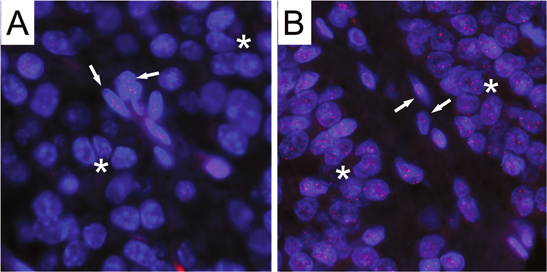Modern Pathology ( IF 7.5 ) Pub Date : 2020-03-18 , DOI: 10.1038/s41379-020-0523-2 Christopher M Heaphy 1, 2, 3, 4 , Wenya Linda Bi 5, 6 , Shannon Coy 7 , Christine Davis 1 , Gary L Gallia 2, 3, 8, 9 , Sandro Santagata 7 , Fausto J Rodriguez 1, 3

|
Telomeres are nucleoprotein complexes located at the termini of eukaryotic chromosomes that prevent exonucleolytic degradation and end-to-end chromosomal fusions. Cancers often have critically shortened, dysfunctional telomeres contributing to genomic instability. Telomere shortening has been reported in a wide range of precancerous lesions and invasive carcinomas. However, the role of telomere alterations, including the presence of alternative lengthening of telomeres (ALT), has not been studied in pituitary adenomas. Telomere length and the presence of ALT were assessed directly at the single cell level using a telomere-specific fluorescence in situ hybridization assay in tissue microarrays. Tumors were characterized as either ALT-positive or having short, normal, or long telomere lengths and then these categories were compared with clinicopathological characteristics. ATRX and DAXX expression was studied through immunohistochemistry. We characterized a discovery set of 106 pituitary adenomas including both functional and nonfunctional subsets (88 primary, 18 recurrent). Telomere lengths were estimated and we observed 64 (59.4%) cases with short, 39 (36.8%) cases with normal, and 0 (0%) cases with long telomeres. We did not observe significant differences in the clinicopathological characteristics of the group with abnormally shortened telomeres compared to the group with normal telomeres. However, three pituitary adenomas were identified as ALT-positive of which two were recurrent tumors. Two of these three ALT-positive cases had alterations in either of the chromatin remodeling proteins, ATRX and DAXX, which are routinely altered in other ALT-positive tumor subtypes. In a second cohort of 32 recurrent pituitary adenomas from 22 patients, we found that the tumors from 36% of patients (n = 8) were ALT-positive. This study demonstrates that short telomere lengths are prevalent in pituitary adenomas and that ALT-positive pituitary adenomas are enriched in recurrent disease.
中文翻译:

垂体腺瘤的端粒长度改变和 ATRX/DAXX 丢失。
端粒是位于真核染色体末端的核蛋白复合物,可防止核酸外切降解和端到端染色体融合。癌症通常具有严重缩短、功能失调的端粒,导致基因组不稳定。已在广泛的癌前病变和浸润性癌中报道了端粒缩短。然而,端粒改变的作用,包括端粒选择性延长 (ALT) 的存在,尚未在垂体腺瘤中进行研究。使用组织微阵列中的端粒特异性荧光原位杂交测定,直接在单细胞水平评估端粒长度和 ALT 的存在。肿瘤的特征为 ALT 阳性或具有短的、正常的、或长端粒长度,然后将这些类别与临床病理学特征进行比较。通过免疫组织化学研究 ATRX 和 DAXX 表达。我们描述了一组发现的 106 个垂体腺瘤,包括功能性和非功能性子集(88 个原发性,18 个复发)。估计了端粒长度,我们观察到 64 例 (59.4%) 短端粒、39 例 (36.8%) 正常端粒和 0 例 (0%) 长端粒。与正常端粒组相比,我们没有观察到端粒异常缩短组的临床病理学特征有显着差异。然而,三个垂体腺瘤被鉴定为 ALT 阳性,其中两个是复发性肿瘤。这三个 ALT 阳性病例中有两个在染色质重塑蛋白 ATRX 和 DAXX 中发生了改变,这在其他 ALT 阳性肿瘤亚型中经常发生改变。在来自 22 名患者的 32 例复发性垂体腺瘤的第二队列中,我们发现来自 36% 患者的肿瘤(n = 8) 为 ALT 阳性。这项研究表明,短端粒长度在垂体腺瘤中很普遍,并且 ALT 阳性垂体腺瘤在复发性疾病中很常见。



























 京公网安备 11010802027423号
京公网安备 11010802027423号